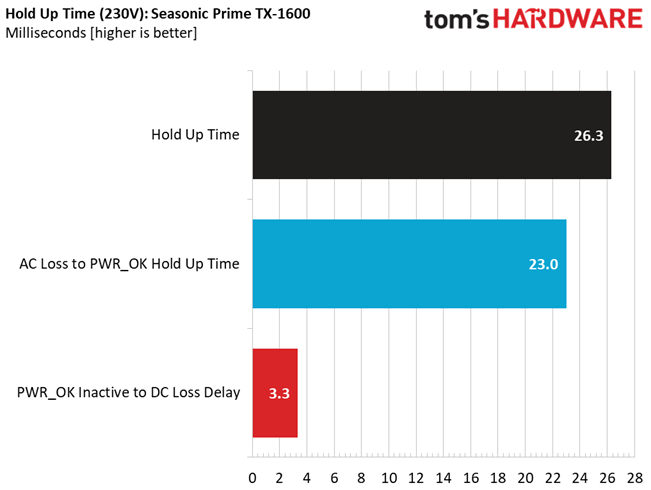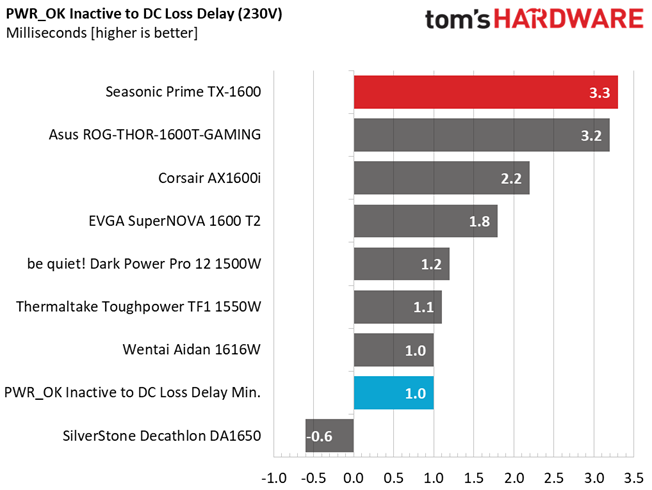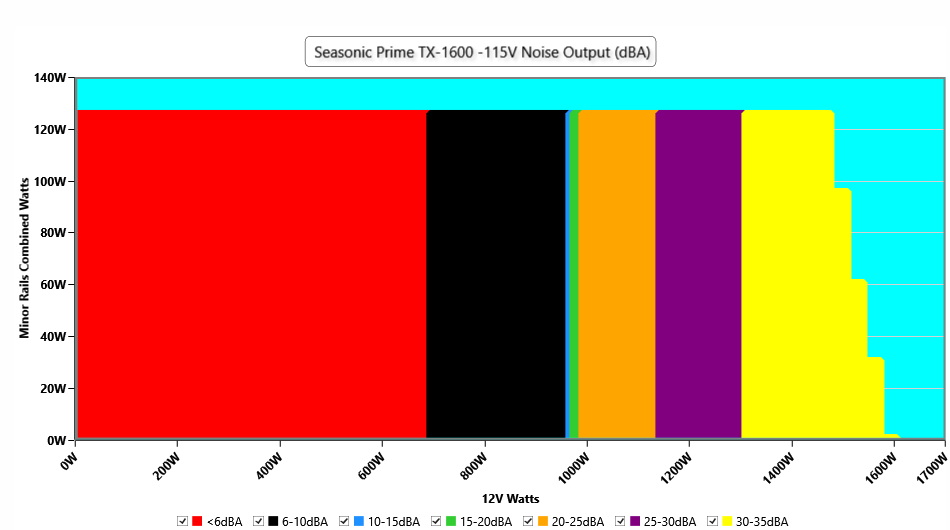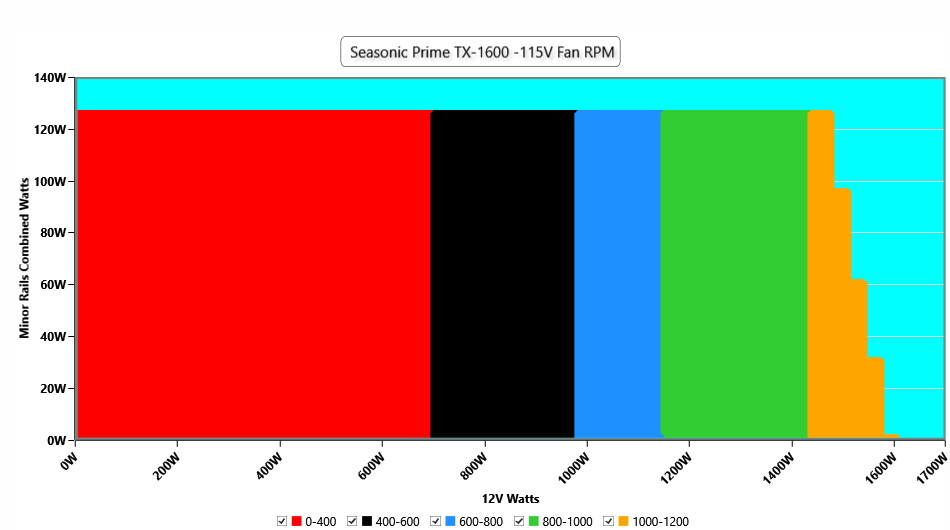Why you can trust Tom's Hardware
To learn more about our PSU tests and methodology, please check out How We Test Power Supply Units.
Primary Rails And 5VSB Load Regulation
The following charts show the main rails' voltage values recorded between a range of 40W up to the PSU's maximum specified load, along with the deviation (in percent). Tight regulation is an important consideration every time we review a power supply because it facilitates constant voltage levels despite varying loads. Tight load regulation also, among other factors, improves the system’s stability, especially under overclocked conditions and, at the same time, it applies less stress to the DC-DC converters that many system components utilize.








Load regulation is not as tight as in the digital units from Corsair, Asus, and Wentai, but it is pretty tight. At 5VSB, the most insignificant rail when it comes to load regulation, the TX-1600 takes over the top spot.
Hold-Up Time
Put simply; hold-up time is the amount of time that the system can continue to run without shutting down or rebooting during a power interruption.




The hold-up time is extra long and the power ok signal is accurate.
Inrush Current
Inrush current, or switch-on surge, refers to the maximum, instantaneous input current drawn by an electrical device when it is first turned on. A large enough inrush current can cause circuit breakers and fuses to trip. It can also damage switches, relays, and bridge rectifiers. As a result, the lower the inrush current of a PSU right as it is turned on, the better.


Inrush current is a bit higher at 115V, compared to most competitors, and at a normal level, given the PSU's capacity, with 230V input.
Get Tom's Hardware's best news and in-depth reviews, straight to your inbox.
Leakage Current
In layman's terms, leakage current is the unwanted transfer of energy from one circuit to another. In power supplies, it is the current flowing from the primary side to the ground or the chassis, which in the majority of cases is connected to the ground. For measuring leakage current, we use a GW Instek GPT-9904 electrical safety tester instrument.
The leakage current test is conducted at 110% of the DUT's rated voltage input (so for a 230-240V device, we should conduct the test with 253-264V input). The maximum acceptable limit of a leakage current is 3.5 mA and it is defined by the IEC-60950-1 regulation, ensuring that the current is low and will not harm any person coming in contact with the power supply's chassis.

Leakage current is higher than the other PSUs in the chart, still much lower than the max allowed limit.
10-110% Load Tests
These tests reveal the PSU's load regulation and efficiency levels under high ambient temperatures. They also show how the fan speed profile behaves under increased operating temperatures.
| Test | 12V | 5V | 3.3V | 5VSB | DC/AC (Watts) | Efficiency | Fan Speed (RPM) | PSU Noise (dB[A]) | Temps (In/Out) | PF/AC Volts |
| 10% | 11.504A | 1.982A | 1.976A | 0.987A | 160.039 | 91.365% | 0 | <6.0 | 44.79°C | 0.976 |
| 12.033V | 5.047V | 3.34V | 5.07V | 175.17 | Row 2 - Cell 6 | Row 2 - Cell 7 | Row 2 - Cell 8 | 40.71°C | 115.13V | |
| 20% | 24.033A | 2.977A | 2.966A | 1.186A | 320.023 | 93.842% | 0 | <6.0 | 45.36°C | 0.985 |
| Row 4 - Cell 0 | 12.030V | 5.041V | 3.338V | 5.061V | 341.027 | Row 4 - Cell 6 | Row 4 - Cell 7 | Row 4 - Cell 8 | 41.05°C | 115.09V |
| 30% | 36.876A | 3.477A | 3.462A | 1.379A | 479.547 | 94.175% | 0 | <6.0 | 46.42°C | 0.985 |
| Row 6 - Cell 0 | 12.026V | 5.035V | 3.336V | 5.077V | 509.224 | Row 6 - Cell 6 | Row 6 - Cell 7 | Row 6 - Cell 8 | 41.67°C | 115.05V |
| 40% | 49.801A | 3.978A | 3.959A | 1.58A | 639.968 | 93.987% | 0 | <6.0 | 47.4°C | 0.989 |
| Row 8 - Cell 0 | 12.023V | 5.029V | 3.335V | 5.066V | 680.904 | Row 8 - Cell 6 | Row 8 - Cell 7 | Row 8 - Cell 8 | 42.36°C | 115.01V |
| 50% | 62.336A | 4.977A | 4.951A | 1.777A | 799.73 | 93.523% | 486 | 9.4 | 42.8°C | 0.992 |
| Row 10 - Cell 0 | 12.019V | 5.025V | 3.333V | 5.065V | 855.115 | Row 10 - Cell 6 | Row 10 - Cell 7 | Row 10 - Cell 8 | 48.34°C | 114.97V |
| 60% | 74.946A | 5.979A | 5.945A | 1.976A | 960.233 | 92.92% | 486 | 9.4 | 43.65°C | 0.994 |
| Row 12 - Cell 0 | 12.015V | 5.019V | 3.331V | 5.062V | 1033.396 | Row 12 - Cell 6 | Row 12 - Cell 7 | Row 12 - Cell 8 | 49.79°C | 114.96V |
| 70% | 87.494A | 6.983A | 6.94A | 2.174A | 1119.99 | 92.317% | 722 | 21.8 | 43.71°C | 0.995 |
| Row 14 - Cell 0 | 12.011V | 5.014V | 3.329V | 5.06V | 1213.194 | Row 14 - Cell 6 | Row 14 - Cell 7 | Row 14 - Cell 8 | 50.77°C | 114.93V |
| 80% | 100.122A | 7.991A | 7.935A | 2.276A | 1280.073 | 91.692% | 822 | 26.1 | 44.3°C | 0.995 |
| Row 16 - Cell 0 | 12.006V | 5.008V | 3.327V | 5.054V | 1396.048 | Row 16 - Cell 6 | Row 16 - Cell 7 | Row 16 - Cell 8 | 52.41°C | 114.88V |
| 90% | 113.093A | 8.5A | 8.42A | 2.378A | 1439.917 | 90.985% | 973 | 31.3 | 44.75°C | 0.996 |
| Row 18 - Cell 0 | 12.002V | 5.001V | 3.326V | 5.048V | 1582.587 | Row 18 - Cell 6 | Row 18 - Cell 7 | Row 18 - Cell 8 | 54.04°C | 114.84V |
| 100% | 125.866A | 9.011A | 8.937A | 2.966A | 1599.951 | 90.214% | 1028 | 33.0 | 45.32°C | 0.996 |
| Row 20 - Cell 0 | 11.998V | 4.995V | 3.324V | 5.059V | 1773.5 | Row 20 - Cell 6 | Row 20 - Cell 7 | Row 20 - Cell 8 | 55.38°C | 114.8V |
| 110% | 138.585A | 10.024A | 10.026A | 2.971A | 1760.605 | 89.374% | 1031 | 33.1 | 46.83°C | 0.996 |
| Row 22 - Cell 0 | 11.994V | 4.989V | 3.322V | 5.049V | 1969.92 | Row 22 - Cell 6 | Row 22 - Cell 7 | Row 22 - Cell 8 | 57.75°C | 114.75V |
| CL1 | 0.117A | 14.948A | 14.895A | 0A | 126.32 | 86.503% | 0 | <6.0 | 50.42°C | 0.971 |
| Row 24 - Cell 0 | 12.026V | 5.038V | 3.33V | 5.016V | 146.013 | Row 24 - Cell 6 | Row 24 - Cell 7 | Row 24 - Cell 8 | 45°C | 115.14V |
| CL2 | 0.116A | 24.771A | 0A | 0A | 126.406 | 85.219% | 465 | 8.8 | 40.89°C | 0.971 |
| Row 26 - Cell 0 | 12.033V | 5.046V | 3.331V | 5.028V | 148.323 | Row 26 - Cell 6 | Row 26 - Cell 7 | Row 26 - Cell 8 | 48.23°C | 115.14V |
| CL3 | 0.116A | 0A | 24.727A | 0A | 83.902 | 79.482% | 439 | 8.2 | 41.15°C | 0.964 |
| Row 28 - Cell 0 | 12.019V | 5.039V | 3.336V | 5.009V | 105.554 | Row 28 - Cell 6 | Row 28 - Cell 7 | Row 28 - Cell 8 | 50.17°C | 115.15V |
| CL4 | 133.335A | 0A | 0A | 0A | 1600.366 | 90.57% | 1027 | 33.0 | 43.51°C | 0.996 |
| Row 30 - Cell 0 | 12.002V | 5.005V | 3.333V | 4.948V | 1766.982 | Row 30 - Cell 6 | Row 30 - Cell 7 | Row 30 - Cell 8 | 54.25°C | 114.8V |
The PSU doesn't have a problem delivering close to 139A at 12V, at high operating temperatures and for prolonged periods. Moreover, its fan spins at low speeds, even during the full load and over-load tests, so the output noise remains low.
20-80W Load Tests
In the following tests, we measure the PSU's efficiency at loads significantly lower than 10% of its maximum capacity (the lowest load the 80 PLUS standard measures). This is important for representing when a PC is idle with power-saving features turned on.
| Test | 12V | 5V | 3.3V | 5VSB | DC/AC (Watts) | Efficiency | Fan Speed (RPM) | PSU Noise (dB[A]) | Temps (In/Out) | PF/AC Volts |
| 20W | 1.234A | 0.494A | 0.493A | 0.199A | 20.013 | 62.29% | 0 | <6.0 | 40.24°C | 0.875 |
| Row 2 - Cell 0 | 12.046V | 5.058V | 3.346V | 5.034V | 32.146 | Row 2 - Cell 6 | Row 2 - Cell 7 | Row 2 - Cell 8 | 37.23°C | 115.17V |
| 40W | 2.719A | 0.692A | 0.69A | 0.298A | 40.008 | 77.593% | 0 | <6.0 | 40.88°C | 0.928 |
| Row 4 - Cell 0 | 12.026V | 5.057V | 3.346V | 5.035V | 51.558 | Row 4 - Cell 6 | Row 4 - Cell 7 | Row 4 - Cell 8 | 37.55°C | 115.16V |
| 60W | 4.202A | 0.891A | 0.888A | 0.397A | 60.006 | 82.444% | 0 | <6.0 | 41.91°C | 0.947 |
| Row 6 - Cell 0 | 12.027V | 5.053V | 3.344V | 5.039V | 72.796 | Row 6 - Cell 6 | Row 6 - Cell 7 | Row 6 - Cell 8 | 38.18°C | 115.15V |
| 80W | 5.682A | 1.089A | 1.086A | 0.496A | 79.975 | 85.897% | 0 | <6.0 | 42.29°C | 0.957 |
| Row 8 - Cell 0 | 12.027V | 5.051V | 3.342V | 5.042V | 93.11 | Row 8 - Cell 6 | Row 8 - Cell 7 | Row 8 - Cell 8 | 38.32°C | 115.15V |
The fan doesn't spin at light loads, if you enable the semi-passive mode.
2% or 10W Load Test
From July 2020, the ATX spec requires 70% and higher efficiency with 115V input. The applied load is only 10W for PSUs with 500W and lower capacities, while for stronger units, we dial 2% of their max-rated capacity.
| 12V | 5V | 3.3V | 5VSB | DC/AC (Watts) | Efficiency | Fan Speed (RPM) | PSU Noise (dB[A]) | Temps (In/Out) | PF/AC Volts |
| 2.456A | 0.277A | 0.277A | 0.055A | 32.151 | 73.199% | 0 | <6.0 | 29.03°C | 0.909 |
| Row 2 - Cell 0 | 12.028V | 5.062V | 3.349V | 5.023V | 43.92 | Row 2 - Cell 6 | Row 2 - Cell 7 | 28.13°C | 115.15V |
The 70% mark is easily passed, with a 2% load.
Efficiency & Power Factor
Next, we plotted a chart showing the PSU's efficiency at low loads and loads from 10 to 110% of its maximum rated capacity. The higher a PSU’s efficiency, the less energy goes wasted, leading to a reduced carbon footprint and lower electricity bills. The same goes for Power Factor.






This is a highly efficient platform, but it could be further improved at light and super-light loads. Not that it delivers mediocre efficiency levels in these load ranges, but because the competition raised the bar too high.
5VSB Efficiency
| Test # | 5VSB | DC/AC (Watts) | Efficiency | PF/AC Volts |
| 1 | 0.1A | 0.501W | 79.601% | 0.06 |
| Row 2 - Cell 0 | 5.005V | 0.63W | Row 2 - Cell 3 | 115.18V |
| 2 | 0.25A | 1.254W | 84.915% | 0.134 |
| Row 4 - Cell 0 | 5.013V | 1.477W | Row 4 - Cell 3 | 115.18V |
| 3 | 0.55A | 2.766W | 86.023% | 0.253 |
| Row 6 - Cell 0 | 5.027V | 3.215W | Row 6 - Cell 3 | 115.18V |
| 4 | 1A | 5.056W | 85.595% | 0.366 |
| Row 8 - Cell 0 | 5.054V | 5.907W | Row 8 - Cell 3 | 115.18V |
| 5 | 1.5A | 7.636W | 84.995% | 0.434 |
| Row 10 - Cell 0 | 5.089V | 8.985W | Row 10 - Cell 3 | 115.18V |
| 6 | 3.001A | 15.44W | 83.152% | 0.528 |
| Row 12 - Cell 0 | 5.146V | 18.569W | Row 12 - Cell 3 | 115.18V |


The 5VSB rail is highly efficient!
Power Consumption In Idle And Standby
| Mode | 12V | 5V | 3.3V | 5VSB | Watts | PF/AC Volts |
| Idle | 12.132V | 5.068V | 3.351V | 5.021V | 12.674 | 0.667 |
| Row 2 - Cell 0 | Row 2 - Cell 1 | Row 2 - Cell 2 | Row 2 - Cell 3 | Row 2 - Cell 4 | Row 2 - Cell 5 | 115.16V |
| Standby | Row 3 - Cell 1 | Row 3 - Cell 2 | Row 3 - Cell 3 | Row 3 - Cell 4 | 0.02 | 0.002 |
| Row 4 - Cell 0 | Row 4 - Cell 1 | Row 4 - Cell 2 | Row 4 - Cell 3 | Row 4 - Cell 4 | Row 4 - Cell 5 | 115.16V |


Vampire power is low with 115V. It would be nice to see below 0.1W with 230V.
Fan RPM, Delta Temperature, And Output Noise
All results are obtained between an ambient temperature of 37 to 47 degrees Celsius (98.6 to 116.6 degrees Fahrenheit).
The fan speed profile is relaxed even at harsh operating conditions. The highly efficient platform helps in that, because energy losses are minimized.
The following results were obtained at 30 to 32 degrees Celsius (86 to 89.6 degrees Fahrenheit) ambient temperature.
At normal operating temperatures, close to 30 degrees Celsius, the PSU's passive operation lasts long and isn't affected by the load on the minor rails. It needs 1300W of load to enter the 30-35 dBA range, so this unit is ideal for high power consumption systems with low output noise.
MORE: Best Power Supplies
MORE: How We Test Power Supplies
MORE: All Power Supply Content
Current page: Load Regulation, Hold-Up Time, Inrush & Leakage Current, Efficiency and Noise
Prev Page Specifications and Part Analysis Next Page Protection Features, DC Power Sequencing, Cross-Load Tests and Infrared Images
Aris Mpitziopoulos is a contributing editor at Tom's Hardware, covering PSUs.
-
watzupken Not unexpected coming from the Seasonic Prime series. However, the lack of ATX 3.0 is going to affect its take up rate. Most people buying a 1.6K W PSU are likely enthusiasts that will want the latest and greatest. This is great, but clearly not the latest.Reply -
escksu 1600W is definitely overkill for most. For the rest of us, a good 600-800W will be sufficient.Reply -
jeremyj_83 Every single time people think that Seasonic will have to go with digital circuits to reach requirements they figure out how to do it with analog circuits. It is amazing that they are able to get the same or better performance using analog circuits compared to most other high end PSUs using digital circuits.Reply -
infopcX Thanks very much for review, amazing work !!!Reply
can we say that this is the second best source money can buy? just behind the Corsair AXi 1600 ?
power factor could be better, in practice compared to the AXi would be imperceptible? would even values below 1% in efficiency be relevant? I say in practice
I would like to know how much we could extract from the Seasonic source? up to 110% Load seemed pretty stable, could we go further with it?
12 years warranty is a plus
Best Regards, -
BoredErica Reply
ax1600i is more aggressive with fan curve vs Seasonic.infopcX said:Thanks very much for review, amazing work !!!
can we say that this is the second best source money can buy? just behind the Corsair AXi 1600 ?
power factor could be better, in practice compared to the AXi would be imperceptible? would even values below 1% in efficiency be relevant? I say in practice
I would like to know how much we could extract from the Seasonic source? up to 110% Load seemed pretty stable, could we go further with it?
12 years warranty is a plus
Best Regards,






